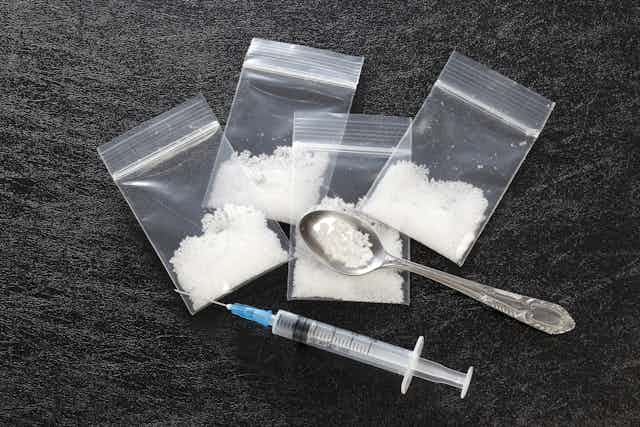Ice is a slang name for crystal methamphetamine – a stimulant drug that is swallowed, smoked or injected. Ice is also called shabu, tina, T, crystal and meth.
It is usually made overseas – from the ingredients pseudoephedrine, iodine and hypophosphorous acid – and imported illegally into Australia. But because the ingredients can be legally imported, ice can also be made here in large quantities.
Ice has been around for years, but a powdered form of methamphetamine called speed was more commonly used in Australia up until about 2010, when ice became more available. Speed and ice are chemically the same drug but instead of a powder, ice is produced in a crystal form that is stronger than speed.

How it works
Because ice is more likely to be smoked than other types of methamphetamines, it enters the bloodstream quickly, which means the effect is faster and stronger than if it were swallowed or snorted. Injecting ice works as quickly as smoking it.
Ice travels to the brain, activating the reward (dopamine) pathway. This is the centre of the brain involved in motivation, euphoria and compulsion.
Ice causes increased amounts of the chemical dopamine to be released, and for long-term users, it becomes difficult to feel pleasure when not intoxicated by ice. This is because the usual pleasurable activities, such as eating chocolate, do not release the same flood of dopamine as ice does.

There are also physical effects on the body: heart rate, blood pressure and body temperature all increase and appetite decreases.
One of the reasons people experience problems with ice is because it is more potent than in the past. Tests of drugs seized by police show it increasing in purity – which means there is a higher concentration of methamphetamine in the product. In early 2011, 50% of drugs captured had a purity of 10% or less. By July to September 2014, average purity was 75% to 80%.
What it’s used for
Ice is used as a stimulant. It will keep people awake; make them feel more energetic as well as capable and confident.
A prescription drug – methamphetamine hydrochloride (brand name Desoxyn) – is sometimes used in the United States to treat attention deficit hyperactivity disorder (ADHD) and obesity that is resistant to other treatments.
However, Desoxyn’s manufacturer provides several warnings about the health and dependency risks of using the drug.
Side effects
Common problematic effects of ice use include insomnia, weight loss, dental problems related to jaw clenching and teeth grinding, dehydration, mental health problems, injuries, infections (related to injecting and also risky sex) and heart palpitations.
People typically experience a “crash” when coming down from ice where they feel physically and emotionally drained. More serious health problems include heart attacks, high blood pressure and stroke. Those dependent on the drug often go back to using it even though they want to stop.
How it was developed
Romanian chemist Lazar Edeleanu created amphetamine sulphate in 1887 from a Chinese plant called ma-huang, also known as ephedra.
In routine commercial drug development, methamphetamine was developed from amphetamine in Japan in 1919 to relieve fatigue. It was widely used in World War II to keep troops awake as well as to treat asthma (because it dilated the bronchial tubes in the lungs) and narcolepsy.
Methampetamine, as opposed to amphetamine, was a crystalline powder that was soluble in water and could be more easily injected than amphetamine sulphate.
Civilians started using methamphetamine during the 1940s, both legally and illegally. It was prescribed as a diet aid, for depression and to treat heroin addiction in San Francisco clinics.
Methamphetamine was used to keep people awake for partying, driving long distances and studying for exams. Considered harmless, methamphetamine was readily available from doctors during the 1960s.
Interesting history

United States President John F. Kennedy received regular injections of methamphetamine to help maintain his youthful vigour, as did other music and film stars.
It has also been rumoured, though not confirmed, that writer Jack Kerouac wrote his famous novel On The Road in a two-week drug-fuelled frenzy. He was taking Benzedrine, a form of amphetamines popular at the time.
Amphetamine psychosis was recognised in medical literature in 1958. British psychiatrist Phillip Connell found that, given enough of the drug, anyone would develop paranoid symptoms including hearing sinister voices coming from toilet bowls and spies watching every move.
Connell found paranoia and psychotic symptoms built up over time as a person continued to take the drug and then went away when they stopped taking it.
Who uses it
Methamphetamine use has declined in Australia from 3.2% of the population in 2004 to 2.1% in 2013, and has stayed relatively steady at around 2% since. This works out to be 268,000 regular users across Australia in 2016; half of these are estimated to be dependent on the drug.
Like most drugs, people who use methamphetamines are generally younger (under 40 years of age) and more often men than women. Use of ice is more common in rural and remote communities and among some groups, especially Aboriginal and Torres Strait Islander people, as well as the gay, lesbian, transgender and transsexual communities.
Methamphetamine is also popular among some in the gay community for chemsex parties – group drug and sex parties that last several days.
Waste water analysis has been used to identify population level methamphetamine use. This is a scientific method that measures the concentration of a drug in the water going into council treatment plants.

A study of two cities in Queensland found a significant increase of methamphetamine in waste water samples between 2009 and 2015. The water analysis findings are consistent with increases in the purity of methamphetamine seized by police and arrests for methamphetamine use and supply during that period.
How much it costs
The price of ice varies from place to place and according to the quantity sold. The Australian Crime Commission reports wholesale prices are between A$90,000 to A$325,000 per kilogram.
The United Nations Office on Drugs and Crime reported the average street price per gram of methamphetamine was between US$500 (A$678) in Australia to US$80 (A$108) in China. People using ice have reported a gram costs A$300 in rural New South Wales.
Ice is usually bought as a point (about a tenth of a gram) for around A$40. A point is enough for one person for a single occasion; perhaps lasting a couple of days depending on the purity of the drug and the tolerance of the person using it.

